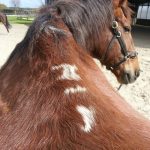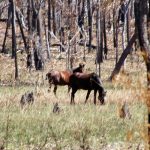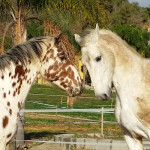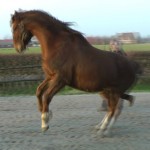 ‘Yes, but he has his ears forward, so it can’t be too bad.’ You may have heard this or something similar mentioned to justify the involvement of a horse in some or other activity. And true, the horse may have their ears forward. Yet horses may also hold their ears forward when they flee either physically or psychologically. My Pip used to be a great one for the latter. If you wanted her to trot around in circles, she would. Faster? Fine. No matter that her saddle dug into her right shoulder at one end and extended over her lumbar region at the other. She would put her ears forward and simply escape from the pain and discomfort by withdrawing into herself and travelling on autopilot.
‘Yes, but he has his ears forward, so it can’t be too bad.’ You may have heard this or something similar mentioned to justify the involvement of a horse in some or other activity. And true, the horse may have their ears forward. Yet horses may also hold their ears forward when they flee either physically or psychologically. My Pip used to be a great one for the latter. If you wanted her to trot around in circles, she would. Faster? Fine. No matter that her saddle dug into her right shoulder at one end and extended over her lumbar region at the other. She would put her ears forward and simply escape from the pain and discomfort by withdrawing into herself and travelling on autopilot.
Continue Reading »
Tags: horses, humans, Pip, willing victim syndrome
Posted in Horses, Humans, Pip, willing victim syndrome | Comments Off
 The horse is first and foremost a prey animal, a creature of flight. How often have we not heard this statement? Everyone who has anything to do with horses seems to trot out this conclusion with the solemnity of the faithful religiously reciting their creed. And the members of the equestrian congregation who hear it nod unthinkingly in agreement, as though acknowledging the first tenet of equine doctrine. This is how we humans define the essence of the horse. No one questions this definition. It is taken as given, a bit like acknowledging that the earth is round. There is a difference, of course. We do not base our approach to the earth on our acknowledgement that it is round. Nor do we use the fact that it is round as the basis for a human approach to the earth which is devastating the planet (mainly through a combination of human induced and facilitated global warming, pollution, mass extinctions, the destruction of biodiversity and related conditions). However, we do use the claim that the horse is first and foremost a prey animal, a creature of flight to justify a human approach to horses which is premised on domination and control to the human’s advantage. Perhaps it is time to question this statement and to establish whether it is indeed an accurate reflection of the essential nature of the horse. Is there a better time to do this than when considering the question of choice? Continue Reading »
The horse is first and foremost a prey animal, a creature of flight. How often have we not heard this statement? Everyone who has anything to do with horses seems to trot out this conclusion with the solemnity of the faithful religiously reciting their creed. And the members of the equestrian congregation who hear it nod unthinkingly in agreement, as though acknowledging the first tenet of equine doctrine. This is how we humans define the essence of the horse. No one questions this definition. It is taken as given, a bit like acknowledging that the earth is round. There is a difference, of course. We do not base our approach to the earth on our acknowledgement that it is round. Nor do we use the fact that it is round as the basis for a human approach to the earth which is devastating the planet (mainly through a combination of human induced and facilitated global warming, pollution, mass extinctions, the destruction of biodiversity and related conditions). However, we do use the claim that the horse is first and foremost a prey animal, a creature of flight to justify a human approach to horses which is premised on domination and control to the human’s advantage. Perhaps it is time to question this statement and to establish whether it is indeed an accurate reflection of the essential nature of the horse. Is there a better time to do this than when considering the question of choice? Continue Reading »
Tags: horses, humans
Posted in Gulliver, Horses, Humans, intrinsic nature | Comments Off
 Horses are highly sociable creatures, almost obsessively so. This is particularly true if we bear in mind that eating is frequently also a social activity and that a great deal of eating occurs in communities of horses. There are some equine ethologists who argue that horses are instinctively sociable for the sole purpose of self-preservation in the face of the constant threat posed by predators, for it is in the herd that they enjoy the best chance of survival. Yet, if we examine the amount of time, energy and effort which horses devote to flight expressed as a percentage of their everyday life when compared to sociability, I wonder whether this is not an example of humans turning reality on its head. Continue Reading »
Horses are highly sociable creatures, almost obsessively so. This is particularly true if we bear in mind that eating is frequently also a social activity and that a great deal of eating occurs in communities of horses. There are some equine ethologists who argue that horses are instinctively sociable for the sole purpose of self-preservation in the face of the constant threat posed by predators, for it is in the herd that they enjoy the best chance of survival. Yet, if we examine the amount of time, energy and effort which horses devote to flight expressed as a percentage of their everyday life when compared to sociability, I wonder whether this is not an example of humans turning reality on its head. Continue Reading »
Tags: Anaïs, followership, friendship, horses, humans, Pip
Posted in Anaïs, followership, friendship, Horses, Humans, Pip, sociable | Comments Off
A lthough the energetical nature of the horse appears to me as something which is so utterly obvious and self-evident, I have yet to come across its mention in any ethological study of horses in the wild in spite of the fact that it is so clearly present in the audio-visual documentaries dealing with the subject matter. For this reason most of my observations and conclusions are based on my experience with horses in captivity, albeit in situations which in some small way seek to emulate the horse’s natural habitat. Continue Reading »
lthough the energetical nature of the horse appears to me as something which is so utterly obvious and self-evident, I have yet to come across its mention in any ethological study of horses in the wild in spite of the fact that it is so clearly present in the audio-visual documentaries dealing with the subject matter. For this reason most of my observations and conclusions are based on my experience with horses in captivity, albeit in situations which in some small way seek to emulate the horse’s natural habitat. Continue Reading »
Tags: energetical, energy, horses, humans, Pip, wild horses
Posted in energetical, energy, Horses, Humans, Kaimanawa, Pip, Uncategorized, wild horses | Comments Off
 Most of the ‘horsey’ humans whom I know will readily concede that horses are capable of learning from each other. All of us seem to have a story to illustrate the point. One of my favourite stories concerns Pip learning to step up onto a pedestal after watching Anaïs do it under Vicki’s guidance. For ages I had tried to get Pip to do the same but every time she simply walked off almost shaking her head as if to say, “You’re crazy”. Caring for Pip while she was having problems with one of her hooves was a watershed experience for us. Her attitude towards me changed completely. I did not realise just to what extent it had, until I took her to the pedestal, put my foot on it and uttered the cue, “Step”, as I had vainly done so many times before. Continue Reading »
Most of the ‘horsey’ humans whom I know will readily concede that horses are capable of learning from each other. All of us seem to have a story to illustrate the point. One of my favourite stories concerns Pip learning to step up onto a pedestal after watching Anaïs do it under Vicki’s guidance. For ages I had tried to get Pip to do the same but every time she simply walked off almost shaking her head as if to say, “You’re crazy”. Caring for Pip while she was having problems with one of her hooves was a watershed experience for us. Her attitude towards me changed completely. I did not realise just to what extent it had, until I took her to the pedestal, put my foot on it and uttered the cue, “Step”, as I had vainly done so many times before. Continue Reading »
Tags: Anaïs, cognition, horses, humans, Pip
Posted in Anaïs, cognition, Horses, Humans, Pip, Uncategorized | Comments Off
« Newer Posts - Older Posts »
 ‘Yes, but he has his ears forward, so it can’t be too bad.’ You may have heard this or something similar mentioned to justify the involvement of a horse in some or other activity. And true, the horse may have their ears forward. Yet horses may also hold their ears forward when they flee either physically or psychologically. My Pip used to be a great one for the latter. If you wanted her to trot around in circles, she would. Faster? Fine. No matter that her saddle dug into her right shoulder at one end and extended over her lumbar region at the other. She would put her ears forward and simply escape from the pain and discomfort by withdrawing into herself and travelling on autopilot.
‘Yes, but he has his ears forward, so it can’t be too bad.’ You may have heard this or something similar mentioned to justify the involvement of a horse in some or other activity. And true, the horse may have their ears forward. Yet horses may also hold their ears forward when they flee either physically or psychologically. My Pip used to be a great one for the latter. If you wanted her to trot around in circles, she would. Faster? Fine. No matter that her saddle dug into her right shoulder at one end and extended over her lumbar region at the other. She would put her ears forward and simply escape from the pain and discomfort by withdrawing into herself and travelling on autopilot.





